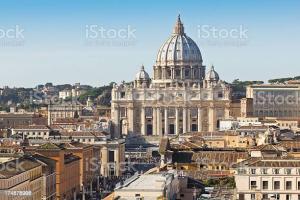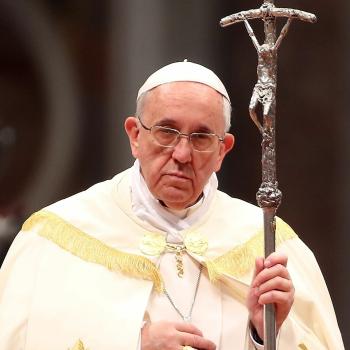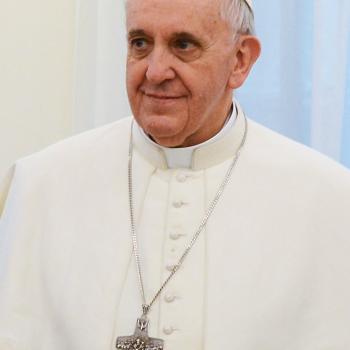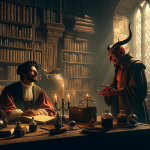
We are at the dawn of a modern dark age that is counterintuitively reliant on advancing technology. For the renaissance to come, we must each recognize and reject the forces pulling us away from one another, and away from the truth.
Fides et Ratio
Saint John Paul II begins his 1998 encyclical, Fides et Ratio, with these words: “Faith and reason are like two wings on which the human spirit rises to the contemplation of truth.” As the late pope, who was canonized in 2013, understood nearly 25 years ago, both faith and reason are fragile.
By “faith,” I mean, per Hebrews 11: “the realization of what is hoped for, and evidence of things not seen.”
By “reason,” I mean, per Saint John Paul II in Fides et Ratio: the ability to use our minds to “observ[e], analyz[e], and asse[ss]” all “realities” around us, such as “the world and all that happens within it, including history and the fate of peoples.”
A Twenty-first Century Dark Age
A dark age is, by definition, an era in which truth is lost because faith and reason are unable to prevail against the eternal human impulses toward superstition and laziness.
In the dark age of medieval times—which began with the fall of Rome in the fifth century and did not end until the fifteenth century—the wisdom of antiquity (from history and art, to government) was lost. Tribes warred with one another in a state of near-anarchy. The Catholic Church (which, it must be acknowledged, was then at the height of its worldly power) opposed popular literacy, which declined accordingly and all but disappeared.
For nearly one thousand years, people—to be clear, women and men just like you and me, not some primordial ancestors we cannot fathom—lived in the dark.
At long last, the Scientific Revolution and the Age of Enlightenment dawned. So did a post-reformation Christianity, both Catholic and Protestant, that engaged faith and reason in ways that transformed the faith and modernized the globe.
Today, the darkness is returning, even as it is suffused in the literal light of screens (that twenty-first century iteration of the once-forbidden fruit, offering the infinite knowledge of God but delivering only a new fall).
A Left Without Reason and a Right Without Faith
Our cultural elites, on both the left and the right, are driven by the cheap measure of “clicks” to avoid truth. Their ambition is to amass likes and shares and other measures of frenzy. Since curated lies are often more divisive (and therefore more click-inducing) than the truth, the leftist mainstream media and many of its right-wing counterparts cut directly against the imperatives of faith and reason.
As a result, we are in danger of winding up bereft of both.
After all, we cannot “rise to the contemplation of truth” when “those whose vocation it is to give cultural expression to their thinking” (i.e., the people with disproportionate impact on the culture) eschew the very concept of universal truth altogether—as, increasingly, they do.
The driving force of today’s left is post-enlightenment emotionalism. Their motto is “we feel; therefore we are.” They are often highly credentialed in ways that would once have signified a well-honed capacity for critical thought. But today’s left is in fact allergic to reason, which demands as a first principle that facts (even ones that feel retrograde or politically incorrect, and even ones that make us sad) be acknowledged as facts.
Meanwhile, the driving force of today’s right is post-Christian arrogance. Their motto is “we know; therefore we are.” They often profess “Judeo-Christian values,” which might once have signaled an empathy that reached beyond the narrow bounds of their own experiences. But today’s right is in fact hostile to true faith, which demands a humility that surpasses even knowledge itself. Per Fides et Ratio: “Our vision in the face of God is always fragmentary and impaired by the limits of our understanding.”
So, on myriad “hot button” issues of the day—from the politics of covid, to those of crime, abortion, gender, race, and the environment—ostensibly well-educated progressives prioritize their own (personal, often virtue-signaling) feelings over the (obvious and other-regarding) dictates of reason. And, on these same issues, ostensibly Judeo-Christian conservatives prioritize their own (limited, often biased) knowledge over the (universal and humble) dictates of faith.
Because of these twin rejections of truth among today’s post-reason left and post-faith right (and because of the social media that feeds on rancor and becomes irrelevant if there is peace), endemic dishonesty breeds increasing polarization. And thus the vicious spiral—downward from truth and into chaos—perpetuates itself.
The Hoped for Renaissance
After the last dark age, modern science and philosophy (along with the reintroduction of art and literature to the wider culture) began with the societal and cultural elites. The learned were the only ones with access to knowledge, and thus the only ones that could pursue and disseminate truth.
This dark age will not be forestalled by learned and elite public figures. With a few exceptions (there are, thank God, always exceptions), those well-known in public life are invested in the manifold spoils of being members in good standing on their own sides.
Hence, if we are to climb out of this new dark age, it will be up to each one of us “normal people” to resist the illiberal, anti-truth tide pulling us unequivocally downward, and yet in two directions simultaneously.
To recognize the imperatives of reason, rather than succumbing to our own feelings. To recognize the mysteries of faith, rather than trusting to our own understanding.
To engage, in Saint John Paul II’s words, “the toil of patient inquiry into what makes life worth living.”
















